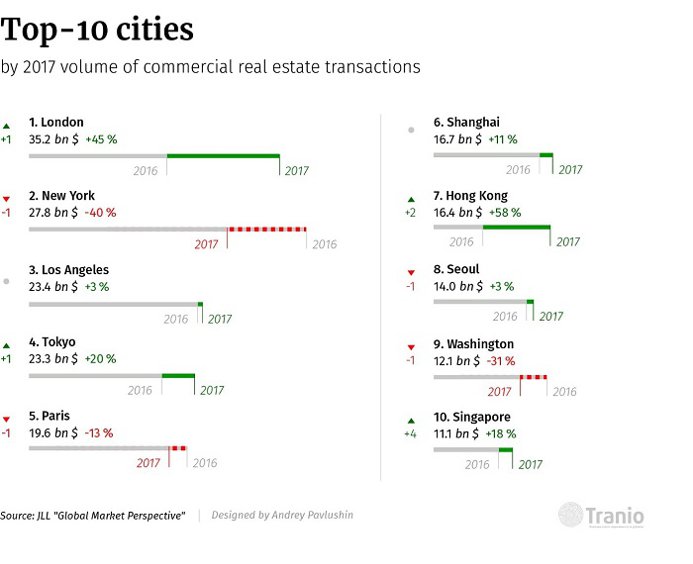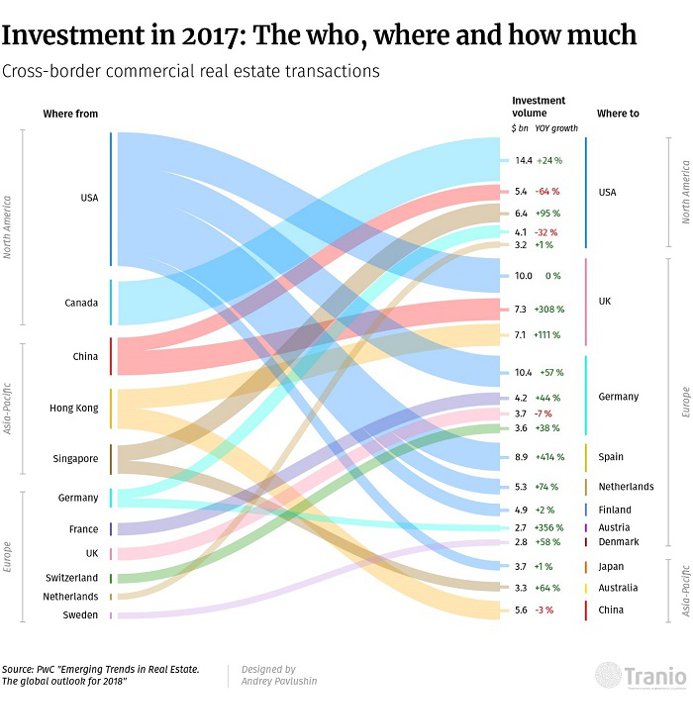How have cross-border commercial real estate transactions shifted since 2017?
Despite North America remaining the largest commercial property market by transaction volume, as little as 15% involves international investors. At the same time, more than half of European transactions are cross-border. The global importance of Asia as both a source of capital and an investment property market is increasing rapidly. According to the reports considered for this article, Asia’s share of cross-border transactions will equal that of Europe’s in the near future. Tranio analysts found out which countries invested in foreign property the most and which became the leaders in attracting international capital.
General market situation
According to the International Monetary Fund (IMF), global GDP grew 3.7% in 2017. The year's results exceeded the figures of the past four years with Asia providing for more than half of the world's economic growth. IMF estimates also found that in 2018–2019 global economic growth rates will remain at the levels of the previous year largely due to the trading confrontation between the world's two largest economies: China and the US.
The United Nations Conference on Trade and Development reported that global foreign direct investment shrank 23% to $1.4tn in 2017, despite the accelerated growth of international trade. As noted in the report, the prime driver for the decline was a significant reduction in the volume of cross-border M&A transactions. The volume of declared investment in new projects also dropped 14%.
However, according to the US consulting company Real Capital Analytics (RCA), the transaction volume in the global commercial real estate market in 2017 remained at 2016’s level ($873bn). This is the second largest result over the past decade. Knight Frank's Active Capital 2018 Report found that the number of cross-border transactions in the global property market has been actively growing again in recent years: their share in the total investment volume grew from 25% in 2009-2011 to 32% in 2017.
US consulting company JLL found that the volume of property transactions closed in 2017 ran at $698bn, and the global real estate market’s transaction amount for the first three quarters of 2018 increased 7% year-on-year to $507bn. According to preliminary estimates, the total amount for the year is going to reach $730bn. However, in 2019, experts expect a slight decrease in investment activity, shrinking to $700bn.
Who is investing?
In 2017, the aggregate amount of foreign commercial property transactions closed by investors from the Asia Pacific region exceeded the volume of the cross-border transactions involving investors from North America and Europe. Knight Frank report that investors from the Asia Pacific region ploughed about $90bn into foreign commercial property (excluding off-plan property), with the US market accounting for $19.8bn and the UK for $19.6bn.

China is the largest investment donor in the Asia Pacific. The volume of cross-border capital flow from China grew 8% between 2016 and 2017, reaching $35.5bn. PwC observed that the volume of Chinese investment in commercial property shrank by over 1.5 times in 2017. However, the decline was offset by the investment in UK real estate, where the volume tripled that year, running at $7.3bn.
H1 2018 investment results justified the concerns about the potential decline in the activity of Chinese investors due to the country's authorities toughening capital control. According to CBRE, in H1 2018, Chinese investments abroad nosedived to $5.26bn (from $25.6bn during the same period of 2017). CBRE estimates put the total volume of investment from China at the lowest in the last five years if these dynamics persist in H2 2018.
Knight Frank analysts also observed a dramatic increase in the 2017 volume of international property investment from Hong Kong and Singapore: by 41% and 35%, respectively. This is largely associated with the limited opportunities for investment diversification and low asset liquidity in their respective domestic markets. In 2017, Hong Kong nationals invested the most in UK ($7.1bn) and Chinese ($5.7bn) property. Singaporean investment in the US commercial property market ran at $6.6bn in 2017. Australia and the UK attracted $3.5bn and $2.8bn, respectively.
European foreign property investment is comparable to that of North America: $83.3bn and $80.9bn. European property markets were the most attractive for both European and North American investors in 2017. North American foreign property buyers had the highest levels of activity in their domestic region ($14bn), the UK ($12.6bn) and Germany ($11.9bn). Europeans increased their investment in German property to $15.9bn. Their next largest property investment destination was the US, which attracted $13bn.
As observed by Knight Frank experts, the markets of continental Europe like Spain, France, Austria and the Netherlands are becoming increasingly popular in spite of the US, the UK and Germany still attracting the most cross-border investments. Specifically, in 2017, Europeans spent $5.3bn in the Netherlands and $5.1bn in France. US nationals invested $5bn in Spanish real estate and the same again in the Netherlands.
Where do they invest?
United States
Although the investment volume in US property had previously declined for two years straight, the US remains the world's largest commercial property market. In 2017, the total transaction amount ran at $375.6bn, 8% less than in 2016. According to Knight Frank, the most active foreign players in the US property market are institutional investors and developers. The latter invested $6.3bn in US office space (institutional investors $10.6bn) and $5.8bn in residential complexes.
Knight Frank also found that Canadian buyers became the largest US property investors in 2017, spending $14bn on US property, outpacing Singaporean investors’ $6.6bn.
Cushman & Wakefield reported that the dramatic decline of Chinese investment most notably affected the commercial property markets of New York (where the total transaction amount shrank 54%) and San Francisco (where it dropped 52%), the cities accounting for two-thirds of the total Chinese investment in US property.
According to JLL, over the first three quarters of 2018, the investment volume in US property increased 14% to $341bn. Experts expect the bottom line figures to grow against 2017.
Europe
A report by the international BNP Paribas banking group observed that in 2017 the total amount of transactions involving European commercial property hit an all-time high of $314bn. Cross-border transactions account for over a half of the amount (52%), this being a seven-year high. JLL estimates that Europe’s property investment volume grew by almost a quarter in 2017; this is more significant than other regions.

United Kingdom
The UK commercial property market continues to be Europe’s largest. Despite the uncertainty stemming from the country's exit from the EU, the annual UK property market surprised experts. As claimed by JLL, in 2017, the volume of transactions involving UK property came in at approximately $79bn, which was 37% more than in 2016. ‘Such a strong performance in the face of continued political upheaval and economic uncertainty demonstrates a long-term investor commitment and confidence in the UK real estate market’, said Alistair Meadows, Head of Capital Markets in the UK with JLL. ‘That is especially true of international investors who account for around half the total volume across the country, and 80 per cent or more of those in London’.
As reported by Knight Frank, the biggest UK property buyers were investors from the Asia Pacific, who spent $19.8bn on it in 2017. JLL analysts observe remarkable activity of investors from Hong Kong and mainland China in London's office segment of the property market. In summer 2017, Hong Kong sauce manufacturer, Lee Kum Kee, bought London's Walkie Talkie skyscraper for a record $1.7bn. Shortly before the purchase, in March, the CC Land development company bought the Leadenhall Building, the highest skyscraper in the City of London, for $1.5bn.

Germany
Record-breaking 2017 figures in Germany buttressed the nation as Europe’s second largest market by volume of cross-border transactions. As claimed by JLL, the total investment volume in German property came to $60.2bn, which was twice as much as in 2012.
BNP Paribas report that international investors took part in over half of the transactions: the amount of cross-border investment was $32.6bn. Germany became Europe's most important foreign real estate market for European and US investors, and the second most important for investors from Asia and the Middle East.
The most popular types of German investment property are office space and logistics real estate. Despite the logistics segment attracting more capital in 2017 than the previous year, the office space market still drew in the greatest share of it: about 43% of the total investment between 2014 and 2017. The vast majority of the transactions are closed in the markets of the ‘Big Seven’: Berlin, Cologne, Düsseldorf, Frankfurt, Hamburg, Munich and Stuttgart.

JLL found that over the first three quarters of 2018, the investment volume in German property increased 8% year-on-year, running at $48bn. Experts anticipate the total purchase value for the year to reach $68bn and the investment in the ‘Big Seven’ to grow by a quarter.
Asia Pacific
The 2017 volume of real estate transactions in the Asia Pacific grew 13% against 2016 to $149bn. International investors took part in about 40% of the transactions. The property markets of Japan and China, where the investment amounts increased by 10% and 5% respectively, topped the list.
The volume of transactions involving Japanese real estate reached $37bn in 2017. The NBIM (Norges Bank Investment Management, managing the assets of the Government Pension Fund of Norway) entrance to the Japanese property market made a remarkable event. At the end of the year, NBIM signed an agreement to acquire a 70% interest in five properties in Tokyo. Chinese property investment hit a record high of $36bn. Hong Kong's real estate market also set a new record, attracting $16bn in 2017: 58% more than the previous year.

We will send you a content digest not more than once a week